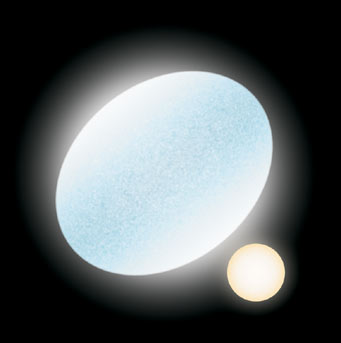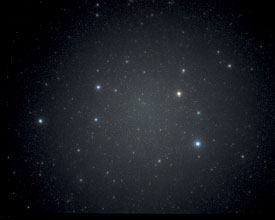The bright star Regulus, shining in Leo 77 light-years away, has long befuddled astronomers. It's not the brightness that puzzles them — though Regulus does emit more ultraviolet and X-rays than models predict. The problem is its spin.
Like many stars of spectral type B (i.e. hot, massive, and young), Regulus rotates much faster than it should, especially considering that it's already about halfway through its (short) hydrogen-fusing lifetime. In fact Regulus spins only 15% below the speed at which it would start to fly apart. This rapid rotation causes Regulus to bulge out around the middle. The result is a star that's not spherical, but oblate.

The shape and size of Regulus compared to the Sun (smaller yellow circle). Regulus's size and shape were measured directly in 2003 and verified in later observations.
S & T
Until recently scientists could only speculate on what causes Regulus's zealous spinning. Astronomers know that a star can speed up if it is a member of an interacting binary system — a close binary whose stars transfer material. In these systems, one star may blow off a heavy stellar wind that blankets its companion in extra mass. In other cases, one star overflows the edge of its gravitational well and spills a thin stream of gas down onto the other. In each the gas hits the star like water from a hose hitting the edge of a ball. The water makes the ball spin; in the case of the receiving star, the stream causes the star to "spin up."
Astronomers already know Regulus to be a multiple system. The main star, Regulus A, has a distant companion that is itself a binary, consisting of two small, dim stars about Regulus A's age. These shine only 1/170 and 1/44,000 times as brightly as the primary. They lie too far away from A to trade mass with it, though, so they cannot explain the spin.
There's also the dilemma that many other type-B stars, such as Vega and Achernar, spin about as quickly but lack any close companion to explain the mystery. Achernar, for example, is even more stretched by its spin than Regulus A: it is 56% wider at the equator that at the poles, whereas Regulus A is only 32% wider. Achernar does have a companion, but it's your run-of-the-mill star, writes Doug Gies, one of the paper's authors, so "such a star is probably not a former mass donor."
But mass transfer may be the answer for Regulus after all. A team of astronomers from the United States, Chile, and Germany has released definitive evidence that Regulus A has a before-undetected close binary companion with at least 1/3 the Sun's mass. The companion has a period of just over 40 days and orbits Regulus A at Mercury's distance from the Sun.
The astronomers, combining data from 10 instruments and more than 20 years of observations, found the companion by studying minute wobbles in Regulus A's spectral lines caused by the companion's gravitational pull. The companion itself is too faint for astronomers to see, and its gravitational effect on the primary star is so small that it remained hidden in radial velocity measurements dating as far back as the late 1800s.
The astronomers offer two possibilities for what the companion is. It could be a low-mass main-sequence star, a cool red dwarf still burning hydrogen in its core. Or it could be a white dwarf, the hot core of a once-massive star that sloughed off its outer layers into space — or was unraveled by a cannibalistic Regulus A — to be left as a superheated skeleton.

Regulus, the bright star in the lower righthand corner, sits at the heart of the lion ancient peoples saw drawn across the sky by these stars. (The arc on the right is the head.)
Courtesy Akira Fujii.
The team favors the white-dwarf explanation. Since the Regulus system is relatively young (between 50 and 150 million years old, depending on whom you ask), the white dwarf would not have cooled off yet and could be much hotter than the primary star. This higher temperature would make it blaze at ultraviolet wavelengths, explaining the mysterious emissions purportedly coming from Regulus A. Mass transfer onto Regulus A from the star the white dwarf used to be would also explain the primary's fast spin.
Disagreement exists, though, as to whether the white dwarf would be hot enough to account for the X-rays. On the other hand, a small main-sequence star of that age would probably have a very active atmosphere emitting strongly in X-rays.
The binary model may not explain other quickly-rotating B stars and Regulus could be a fluke. But Gies notes that astronomers have found signs of hot subdwarf companions that went unnoticed for decades around other well-studied stars, so "the lack of evidence may not be surprising."
Despite the lingering questions, the news of Regulus A's companion falls on welcoming ears. "There have always been hints that Regulus was a spectroscopic binary," writes Edward Guinan of Villanova University, "but this study nails it down conclusively."
 2
2
Comments
Jagadheep Pandian
July 4, 2008 at 5:53 am
Vega is spectral type A0 V, and is not a B-star.
You must be logged in to post a comment.
Peter L.
July 10, 2008 at 2:17 pm
If Regulus turns out to be a spectroscopic binary with a white dwarf shouldn't the dwarf accrete mass since its density is so much higher than that of Regulus? The article alluded to Regulus accreting mass from the dwarf's progenitor star. At some point the white dwarf will accrete mass from Regulus as it is close enough to do so, and when it reaches 1.44 times the mass of the sun... It would blow up as a type 1A supernova. At 77 light years from Earth our planet would surely be affected in an adverse way and could quite possibly destroy the atmosphere. I would think astronomers would want to find out more about this threat, even if it is in the distant future...
You must be logged in to post a comment.
You must be logged in to post a comment.